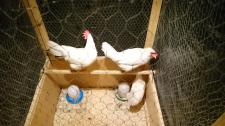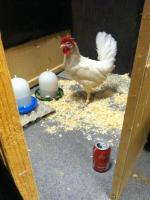Material and Methods
Domestic White Leghorn chickens in this study came from Swedfarm, a commercial hatchery where half were incubated and hatched. Day old chicks were exposed to standard industry procedures such as handling, sorting and vaccinations. These chicks were the hatchery stress group (HS). The other half, the control group, were incubated and hatched at Linköping University. When chicks were adults, they all went through a series of behavioral testing to assess their stress reactivity and level of fearfulness.
Emergence test

All birds were individually placed in a box where a trap door opened so that the bird could enter an arena. The latency was recorded for the time it took for each bird to exit the box. Each bird was given a maximum of 300 seconds to emerge.
Social regrouping test

3 birds of the same sex and treatment were penned together where various behaviors were observed and recorded using 1/0 sampling to obtain a baseline value. In order to induce a stressor, the birds' social dynamics were disrupted by regrouping them. Each bird was placed in a new pen with new cagemates for 5 consecutive days. After the birds were regrouped for 5 consecutive days, they were returned to their original pens. Another session of behavioral observations and recordings took place in the same manner as baseline recordings.
Novel object test

Each bird was individually placed in a pen similar to the pens in the social regrouping test. A novel object (coke can) was placed in the pen where the latency was recorded for the bird to peck the can. Various behaviors were also observed and recorded using 1/0 sampling. Each bird was given a total of 300 seconds in the pen.
Responsible for this page:
Director of undergraduate studies Biology
Last updated:
06/14/16
